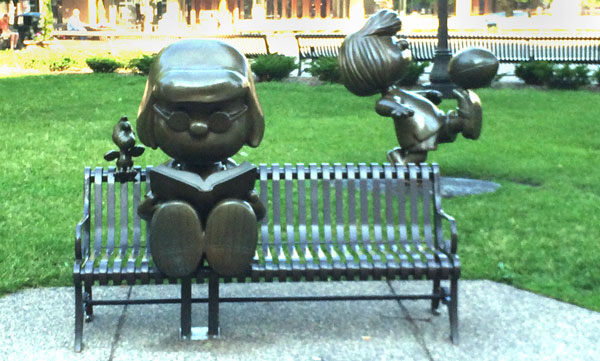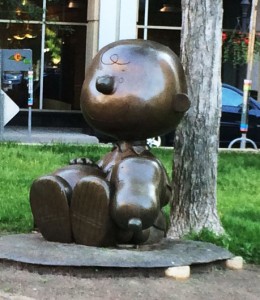 Lucy reading on a park bench in the Twin Citie
Lucy reading on a park bench in the Twin Citie
Here's a simple formula to make a park exciting. Add a sculpture in front of a park bench and you have essentially transformed a plot of grass into an outdoor museum.
It certainly works for St. Paul, Minn. They added hundreds of statues from the Charlie Brown cartoon series and have turned many of their parks into tourist destinations, creating a sense of civic pride as well with local residents.
There is a connection between the city and the Charlie Brown creator Charles Schultz. He was born there and went on to become one of the most popular cartoonists in history. At his peak, his "Peanuts" comic strip was featured in 2,600 newspapers which spawned several TV specials as well.
When he died in 2000 at the age of 77, the statues were created to honor his legacy.
Now more than 100 statues of Charlie Brown, Lucy, Linus, Snoopy and Woodstock can be seen interspersed in parks all over the Twin Cities. Created by famous artist Tivoli Too, most of the sculptures are about 5 feet tall and are smoothly polished so they are kid-friendly. This allows children to touch and climb the statues, something we're sure would have pleased Schultz immensely.
 Charlie Brown in a par
Charlie Brown in a par
With a few of the sculptures, the characters sit on a park bench, as if they were just another park visitor. You can also view Linus with a blanket and Peppermint Patty kicking a football (for some reason, Pigpen was excluded from the bunch).
Commission an artist, place the sculpture in a park and add a park bench to view it
This brings us to a bigger discussion. Not every city has a Charles Schultz who was born there. But many cities do have local artists who are quite talented. What better way to create a unique attraction to any town then by featuring artwork from local residents in the park?
Sculptures in parks are an established norm in Europe. Many museums in Europe and America now feature sculpture parks on their grounds.
But few public parks feature sculptures. That is starting to change. Today sculpture parks can be found in nearly every state.
Here are a few:
Laumeier Sculpture Park - 105 acres in St. Louis.
Storm King Art Center - 500 acres in the Hudson River Valley, New York.
Oliver Ranch - 100 acres north of San Francisco.
Kentuck Knob - 80-acres in Southwestern Pennsylvania.
The Sculpture Ranch - 143-acres in the hill country of Texas (formerly President Lyndon B. Johnson's ranch).
Some of the more interesting sculptures we've seen that captivate visitors and onlookers include mustangs running through a fountain, hippos emerging from the ground and a gun barrel twisted into a knot (visit this page to see them).
Adding a sculpture to a park is certainly a major project. First of all, there is the cost. Many of the parks with sculptures have very generous benefactors. A fund-raising drive would probably be very popular since the artwork would be available for everybody to see. Also, a request for a grant could be submitted to a city, country or state arts foundation.
The famous outdoor artist Christo would pay all the costs for his outdoor works, including the famous Gates exhibit which he created for New York City's Central Park. That project installed 7,503 vinyl "gates" along pathways and used 5,390 tons of steel, 99,155 square meters of fabric and 15,000 sets of brackets and hardware.
Christo reportedly makes his money from selling preparatory works or earlier artworks. That's always a possibility as well for any local artist, albeit on a much smaller scale.
Public sculpture gardens are a relatively new phenomena in the United States. The Laumeier Sculpture Park opened in 1977 and at that time was apparently one of the first in the nation.
Whatever type of artwork a town chooses, from a Snoopy to something totally experimental like the giant mirrored "Cloud Gate" bean-like thing in downtown Chicago, a simple artistic addition to any park can create a major draw to the area.
Christo's Gates reportedly attracted four million, that's right, four million visitors from around the world. That's not only art, that's economic development, which every city official loves to see.
Once you add a piece of art, the only other project is to be sure to add a park bench for viewing and contemplation. The media and word of mouth will take care of the rest. That's the power of art in a park.
For a map of sculpture parks in the US and the rest of the world, click here.
To find the right park bench to park in front of a sculpture, visit The Park Catalog here.


